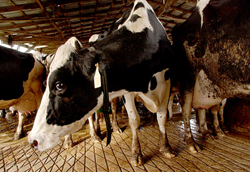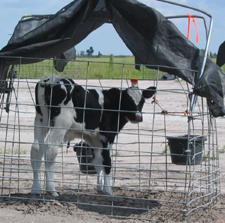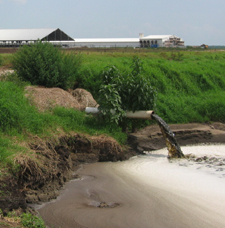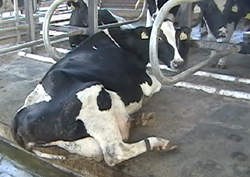
|
Dairy
Production in Florida The lives of dairy cows are a bleak cycle of pregnancy, birth and milking to provide one thing—milk for human consumption. The heat and humidity of Florida’s climate makes life difficult for dairy cows. Florida’s hot and wet conditions also increase health problems such as mastitis, a common but serious bacterial infection of the mammary gland. In an attempt to fight the heat, and to better control waste, farms confine cows in warehouse-sized buildings that have giant fans running 24 hours a day. But confining cows creates other problems. As a result of standing on concrete, and from lack of exercise, dairy cows commonly suffer from painful feet or leg injuries. Lameness is one of the most frequent reasons that dairy farmers kill cows. The
Short, Sad Life of a Dairy Cow Male calves are of little value to the dairy industry, so dairy farmers sell them to the notoriously cruel veal industry (there would be no veal without the dairy industry!), or just abandon them at the farm. In 2000, workers at a dairy farm in Okeechobee were caught on film dumping day-old calves in a pit, and shooting them with a pistol.
Before a calf leaves the pen, she will be dehorned, a painful and stressful mutilation, usually conducted without anesthesia (farmers explain that dehorning reduces injuries in the crowded dairy). Before the calf turns two, she will be artificially inseminated and begin her “productive life.” Cows are milked twice, even three times per day, and are pushed to produce as much as 20,000 lbs of milk per year! After a few short years, a cow’s milk production declines and she is sold for slaughter. Cows are also killed if they have difficulty getting pregnant, or due to chronic mastitis or lameness, anything that makes her no longer profitable. A cow’s natural lifespan is 25 years or more. |
|
On
dairy farms, enormous quantities of water are used to clean the
animals and milking equipment, in operating sprinklers to cool
animals, and in flushing manure out of barns—in addition
to the water cow’s drink. A study by the University of Florida
estimated that 100 cows can produce over 100,000 gallons of wastewater
each week! It is not surprising that dairies are one of Florida’s most significant sources of water pollution. (The ammonia and other gases from manure can also contribute to air pollution.) |
|
Strong
Bones? Cow's
milk is high in calories, fat and cholesterol, and frequently
contains antibiotics, hormones and other drug residues. Millions
of Americans are dairy (lactose) intolerant. Beyond
Dairy. ARFF recommends that people wishing to reduce animal suffering minimize or, better yet, eliminate animal products from their diet. Contact ARFF for ideas on how to make the change to a healthier, animal-free lifestyle. Please
download
and distribute our handout
( |
|
ARFF
investigation reveals animal neglect, unsafe conditions at UF
dairy farm
In November 2006, ARFF was contacted by a former employee of the University of Florida’s Dairy Research Unit near Gainesville who reported serious problems at the facility. An ARFF volunteer visited the facility to investigate and confirmed several of the allegations of mismanagement and neglect.
ARFF filed a complaint with the University of Florida urging them to investigate. The university responded and admitted that problems do exist. Hopefully, ARFF’s complaint and an article that followed in a local newspaper will lead to improvements at the dairy farm. Although the allegations and the conditions ARFF documented at the farm were shocking, they are not uncommon in Florida dairy farms. Even the best dairy farm can’t avoid abuses that are inherent to the industry, such as female calves forcibly taken from their mothers shortly after birth, and males calves cruelly disposed of. After a few short years, when a cow’s milk production declines, all dairy cows are sold for slaughter. The best way to help end the suffering of cows in the dairy industry is to eliminate dairy and all animal products from your diet. The former university employee told ARFF that she had worked at the facility for two years, and in that time she watched cows that she had fallen in love with deteriorate before her eyes. Because of her experience, she has stopped drinking millk. |
|
|
1431 N. Federal Highway • Fort Lauderdale, Florida 33304 • (954) 727-ARFF



 Dairy
farming is one of Florida’s biggest animal industries, second
only to the beef cattle industry in dollar value. For decades,
the number of dairy farms in Florida has been in decline, while
the size of herds on individual farms has increased dramatically.
Today, most dairy farms in Florida have between 500 and 1000 cows,
and several huge mega-dairies have over 3000 cows!
Dairy
farming is one of Florida’s biggest animal industries, second
only to the beef cattle industry in dollar value. For decades,
the number of dairy farms in Florida has been in decline, while
the size of herds on individual farms has increased dramatically.
Today, most dairy farms in Florida have between 500 and 1000 cows,
and several huge mega-dairies have over 3000 cows! Young
female calves are moved into tiny, individual pens where they
spend the first weeks of their lives, cut off almost completely
from contact with other cows. A strip of fabric serves as shade.
Farmers claim that they must isolate calves to protect them from
infectious disease, noxious ammonia and other threats to young
animals that are common in modern dairy farms.
Young
female calves are moved into tiny, individual pens where they
spend the first weeks of their lives, cut off almost completely
from contact with other cows. A strip of fabric serves as shade.
Farmers claim that they must isolate calves to protect them from
infectious disease, noxious ammonia and other threats to young
animals that are common in modern dairy farms.  The
Environment
The
Environment
 The
allegations included: (1) cows becoming sick after eating screws
and wire left behind by maintenance crews, plastic gloves used
in breeding and other improperly disposed garbage; (2) cows suffering
broken bones or other life-ending injuries after slipping on poorly
maintained surfaces; (3) an injured or sick cow improperly euthanized
by several gunshots to the head; (4) cows not treated at first
sign of illness or injury, especially when the illness did not
immediately affect milk production; (5) animal cruelty. ARFF learned
of an incident in which an employee at the facility whipped an
uncooperative cow with his belt.
The
allegations included: (1) cows becoming sick after eating screws
and wire left behind by maintenance crews, plastic gloves used
in breeding and other improperly disposed garbage; (2) cows suffering
broken bones or other life-ending injuries after slipping on poorly
maintained surfaces; (3) an injured or sick cow improperly euthanized
by several gunshots to the head; (4) cows not treated at first
sign of illness or injury, especially when the illness did not
immediately affect milk production; (5) animal cruelty. ARFF learned
of an incident in which an employee at the facility whipped an
uncooperative cow with his belt.